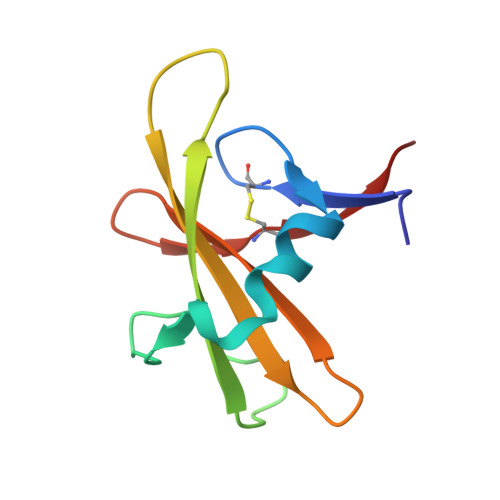Structural polymorphisms within a common powdery mildew effector scaffold as a driver of coevolution with cereal immune receptors.
Cao, Y., Kummel, F., Logemann, E., Gebauer, J.M., Lawson, A.W., Yu, D., Uthoff, M., Keller, B., Jirschitzka, J., Baumann, U., Tsuda, K., Chai, J., Schulze-Lefert, P.(2023) Proc Natl Acad Sci U S A 120: e2307604120-e2307604120
- PubMed: 37523523
- DOI: https://doi.org/10.1073/pnas.2307604120
- Primary Citation of Related Structures:
8OXH, 8OXI, 8OXJ, 8OXK, 8OXL, 8PHY - PubMed Abstract:
In plants, host-pathogen coevolution often manifests in reciprocal, adaptive genetic changes through variations in host nucleotide-binding leucine-rich repeat immune receptors (NLRs) and virulence-promoting pathogen effectors. In grass powdery mildew (PM) fungi, an extreme expansion of a RNase-like effector family, termed RALPH, dominates the effector repertoire, with some members recognized as avirulence (AVR) effectors by cereal NLR receptors. We report the structures of the sequence-unrelated barley PM effectors AVR A6 , AVR A7 , and allelic AVR A10 /AVR A22 variants, which are detected by highly sequence-related barley NLRs MLA6, MLA7, MLA10, and MLA22 and of wheat PM AVR PM2 detected by the unrelated wheat NLR PM2. The AVR effectors adopt a common scaffold, which is shared with the RNase T1/F1 family. We found striking variations in the number, position, and length of individual structural elements between RALPH AVRs, which is associated with a differentiation of RALPH effector subfamilies. We show that all RALPH AVRs tested have lost nuclease and synthetase activities of the RNase T1/F1 family and lack significant binding to RNA, implying that their virulence activities are associated with neo-functionalization events. Structure-guided mutagenesis identified six AVR A6 residues that are sufficient to turn a sequence-diverged member of the same RALPH subfamily into an effector specifically detected by MLA6. Similar structure-guided information for AVR A10 and AVR A22 indicates that MLA receptors detect largely distinct effector surface patches. Thus, coupling of sequence and structural polymorphisms within the RALPH scaffold of PMs facilitated escape from NLR recognition and potential acquisition of diverse virulence functions.
- Department of Plant Microbe Interactions, Max Planck Institute for Plant Breeding Research, Cologne 50829, Germany.
Organizational Affiliation:
















